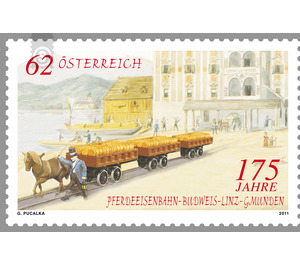175 years - Austria / II. Republic of Austria 2011 - 62 Euro Cent
Theme: Traffic, Transportation & Mobility
| Country | Austria / II. Republic of Austria |
| Issue Date | 2011 |
| Face Value | 62.00 |
| Edition Issued | 6,000,000 |
| Printing Type | offset |
| Stamp Type | Commemorative |
| Item Type | Stamp |
| Chronological Issue Number | 2258 |
| Chronological Chapter | OOS-OE2 |
| SID | 840828 |
| In 72 Wishlists | |
The present special stamp commemorates the 175th anniversary of a railway line, which, according to today's feeling, looks a bit strange: the horse-drawn railway Budweis - Linz - Gmunden. This section was opened between 1827 and 1836 sections of railway was after that, between Saint -Étienne and Andrézieux reversed, the second public rail line on the European mainland and was used mainly for the transport of salt from the Upper Austrian Salzkammergut to Bohemia. In the years 1855-1856 it was gradually converted to steam operation between Linz and Gmunden, but on the mountainous route between Linz and Budweis this conversion was not possible because of too narrow radii of curvature and too large gradients. Until 1873, therefore, a replacement route was built with mostly different route between Linz and Budweis, which allowed the steam operation. In December 1872, the horse-drawn railway operation was finally discontinued. The story: The groundbreaking ceremony took place on 25 July 1825 at Nettrowitz north of Budweis. The Prague professor of higher mathematics, Franz Josef Ritter von Gerstner (1756-1832), who was commissioned with the planning work, and the up to 6,000 workers, however, encountered numerous problems. In addition to mastering technical difficulties and overcoming a height difference of up to 540 meters, it was necessary to live with the resistance of the local population, which was involved in some way in the salt transport by horse-drawn vehicle and feared for their source of income. In addition, tensions soon arose between the project management and the builders. After countless elaborate construction works and several sections, which went into operation gradually, the operators were confronted again and again with new difficulties. For example, the multiple track of the track, despite numerous evasions, too often led to problems with unexpected oncoming traffic. Only after the introduction of the telegraph at the end of the 1850s could these unpleasant disturbances of the railway operations be satisfactorily resolved. With the construction of the Empress Elisabeth Railway (Westbahn) finally came the gradual end of the horse-drawn railway. Only in 1970, the remaining remains of the horse tram in Austria were declared as cultural monuments. In 1982, a "horse-drawn railway trail" was opened from Unterweitersdorf to the Austrian-Czech state border west of Leopoldschlag, which was extended in 1999 across the border to the former station in Bujanov (Angern).


